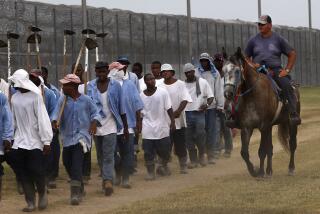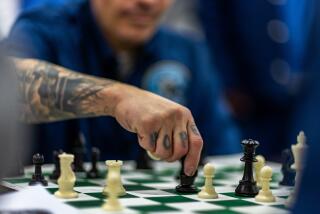Buck the norm with a trip to the Angola Prison Rodeo
- Share via
Sure, you could go to the jazz festival in New Orleans again this spring.
But don’t underestimate the Angola Prison Rodeo. It’s a chance to see serious felons testing their mettle against serious livestock. It’s a glimpse of an infamous lockup, bordered on three sides by the Mississippi River, where blues musician Leadbelly once did time. It’s an introduction, amid plenty of homegrown food and music, to the peculiarly tangled history of public incarceration and private enterprise in the Tunica Hills of rural Louisiana.
“You really can’t describe it. You have to experience an Angola rodeo,” says Gary Young, project coordinator for the Louisiana State Penitentiary.
And don’t worry. We’ll tell you how to get tickets in a minute.
The Louisiana State Penitentiary at Angola, once labeled the bloodiest prison in America, holds about 5,200 inmates and sprawls across 18,000 acres in West Feliciana Parish, 137 miles northwest of New Orleans. The penitentiary’s crops include corn, soybeans, tomatoes, onions, cabbage, okra, peppers, squash, cotton and wheat. Its livestock includes hundreds of cattle and horses.
If the prison is beginning to sound more like an agribusiness than a big house, it’s both. Remember that for much of the 19th century, Louisiana relied on private contractors to run its penitentiary system, using inmates as laborers. A single family ran Louisiana’s system from 1869 to 1900, apparently sometimes housing inmates in old slave quarters.
By the 1920s, the state had taken direct control of the Angola prison site, which takes its nickname from the African region where many slaves were shipped from in centuries past. For decades, historians say, the prison lurched through cycles of reform and lapses into brutality. Broader improvements began in the 1970s, and despite recurring controversies (go to www.angola3.org to see the case of the “Angola 3”), Angola is now often praised for its inmate magazine and radio station, vocational training and even a degree program in theology.
The rodeo, a joint project of prison workers and inmates, came about in 1965. Two years later, authorities opened the rodeo to outside spectators, who sat on apple crates. Pretty soon, the prison put up bleachers, adopted the Professional Rodeo Cowboys Assn. rules, brought in professional stock animals and clowns and added an arts-and-crafts festival. A new stadium opened in 2000 with a capacity of 10,000. Nowadays, there’s a spring rodeo -- this year, April 18 and 19 -- and a series of rodeos every Sunday in October. Sellouts are common.
The events include Guts & Glory, in which contestants grab at a wooden poker chip tied to the horn of a bull, and Convict Poker, in which four inmates enter the arena and sit in chairs around a poker table. Then a bull is let loose. Last man sitting wins. Prizes, which the inmates can keep, are typically $200 to $300.
“It’s exuberating,” Guts & Glory contestant Jerry Brown told a reporter in 2004. (No, this was not the Jerry Brown who serves as California’s attorney general, though that is entertaining to imagine.)
Authorities say there’s never been a fatality, although, as Young notes, “it’s the nature of the beast” to inflict minor injuries now and then.
As many as 1,000 inmates have roles in the event, from selling crafts to manning concession booths to riding broncs. Inmate artists compete to design posters, and inmate bands perform before and during the show. Concession stands peddle jambalaya, funnel cakes, ribs and cracklins ( www.deltablues.net/cracklin.html), all prepared by inmates.
Proceeds from the rodeo go to the Louisiana State Penitentiary Inmate Welfare Fund, which pays for inmates’ educational and recreational supplies, and construction of interfaith chapels. And those are just some of the many ways in which the prison’s infamy brings in money.
Angola’s leaders call their institution “the most visited prison in the world,” with more than 1,000 tourists monthly, besides the roughly 70,000 people who come each year on rodeo days. Parts of “Dead Man Walking” and “Monster’s Ball” were shot at Angola. A 30-minute documentary on the rodeo, “The Wildest Show in the South,” was nominated for an Academy Award in 2000.
The prison’s Red Hat Cell Block (where the most dangerous inmates were held in the old days) was added to the National Register of Historic Places in 2003. The gift shop stocks Angola shot glasses ($3), ashtrays ($5), hot sauce ($3) and boxer shorts ($13).
Rodeo admission is $10; details at www.angolarodeo.com. Cellphones, cameras and alcohol are banned. And the rodeo need not be your only stop at the penitentiary.
There’s also the Louisiana State Penitentiary Museum ([225] 655-2592; www.angolamuseum.org) just outside the prison gate. And don’t overlook the Prison View Golf Course ( www.prisonviewgolf.com), which is open to the public (no firearms, no alcohol, no convicted felons) and affords “a spectacular view of Louisiana’s only maximum security prison.” Green fees ($10) go to the Louisiana State Penitentiary Employee Recreation Committee, which runs the place.
And if you’re thinking about spending the night -- no, the penitentiary can’t help you. But St. Francisville, 20 miles up the road, is a quaint little town ( www.stfrancisville.net) with close to a dozen B&Bs.;
--
More to Read
Sign up for The Wild
We’ll help you find the best places to hike, bike and run, as well as the perfect silent spots for meditation and yoga.
You may occasionally receive promotional content from the Los Angeles Times.







